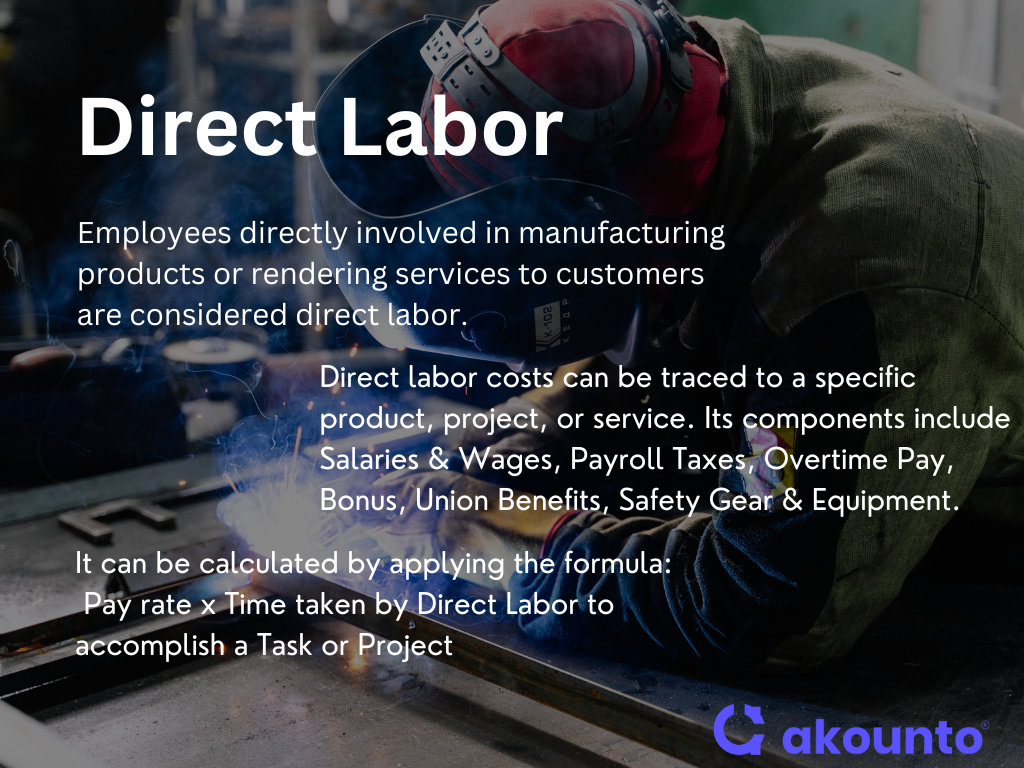Introduction
Direct labor refers to the labor cost directly associated with producing goods or providing services within a business. The fringe benefits and wages paid to employees directly involved in manufacturing, assembling, and delivering products or services directly to customers are known as direct labor costs.
What’s covered in the article
Direct labor includes costs of regular working hours, payroll taxes, overtime hours, Medicare, employment insurance, bonus, unemployment tax, etc.
Some companies may also include costs related to employees’ hiring, training, and development incurred during their employment as direct labor cost.
The labor costs are considered variable as they fluctuate based on the business’s production or service activity level. As production increases, direct labor costs increase and fall if production decreases.
Most companies establish a standard hourly rate to estimate the direct labor cost in normal conditions. For example, Company SSS’s direct labor cost per hour for assembling car seats is $20. The company expects to use 0.5 hours to assemble each car seat. If Company SSS produces 1,000 units, the standard direct labor cost would be $10,000 ($20 x 0.5 x 1,000).
Importance
Direct labor costs are of significant importance for a small business due to the following reasons.
- Cost Management: Direct labor represents a major portion of the overall production costs for small businesses, and managing these costs can directly impact the company’s profitability. So small businesses must closely monitor and control to ensure that the labor costs align with their budget and production requirements.
- Pricing Decisions: Direct labor costs are crucial when setting appropriate product or service prices. Pricing too low can lead to potential losses for a business, like low-quality product/service perception, inability to cover business costs, limited customer loyalty, and reduced investment capacity for growth and expansion.In contrast, pricing too high may deter customers from making the purchase. Factoring in direct labor costs can help establish competitive and sustainable pricing strategies.
- Resource Allocation: Accurate tracking of direct labor allows small businesses to allocate resources effectively and make efficient decisions related to workforce planning, hiring, and training investments to meet production needs.
- Competitiveness: Analyzing differences between budgeted and actual labor cost helps small businesses identify cost overruns or cost-saving opportunities, especially in labor-intensive industries. Management can take corrective actions and implement strategies to improve cost efficiency.
- Decision-Making & Productivity: A clear understanding of direct labor costs is vital for making informed strategic decisions affecting the company’s overall performance, such as automating processes, outsourcing certain tasks, expanding operations, and diversifying products or services.
- Compliance: Properly accounting for direct labor costs is necessary for accurate financial reporting and compliance with accounting standards and tax regulations.
- Labor Relations: Understanding direct labor costs and fairly compensating direct labor employees can positively impact labor relations. Transparency and appropriate facilitation of direct laborers can contribute to employee satisfaction, reduced turnover, and motivation.

Components
Direct labor costs can be traced to a specific product, project, or service. The components of direct labor costs are as follows:
- Salaries & Wages: These are generally paid to the employees/workers for the goods produced or services rendered. They are calculated based on an hourly rate, daily rate, or monthly salary.
- Payroll Taxes: Companies are liable for remitting and withholding varied employee payroll taxes on behalf of their workers. These include Medicare, social security, unemployment insurance, and other state and federal taxes.
- Overtime Pay: When employees/workers work beyond their regular working hours, they are entitled to overtime hours pay. The additional compensation is often at a higher rate than regular working hours pay and is used to incentivize employees to work longer hours during peak production periods.
- Bonuses or Performance-based incentives: Companies can offer these to reward and motivate employees to achieve specific product targets, meet quality standards, or achieve other specific project goals.
- Benefits: Apart from basic wages paid, companies can also provide varied other benefits to their direct workers, such as sick leave, paid time off, life and health insurance, and other fringe benefits.
- Union Benefits: If the direct labor workers are unionized, a business company may need to factor in the cost of union benefits and other dues as part of direct labor costs.
- Safety Gear & Equipment: Providing necessary safety gear and equipment for workers to perform their tasks safely is considered direct labor cost.
Calculation
Formula
The formula to calculate direct labor costs is; Pay rate x Time taken by Direct Labor to accomplish a Task or Project
Steps
- Identify all direct labor expenses: Direct labor refers to employees who work directly in producing a product or providing services. These direct employees could be salaried or paid a direct labor hourly rate.
- Determine hourly labor costs: Direct labor cost per hour can be calculated by dividing Total Direct Labor Expenses for a given period by the Total Number of Hours Worked during that period. Example: a company’s factory employee’s total direct labor expenses are $50,000 per year. He worked 2,080 hours per year (40 hours a week, there being 52 weeks in a year). Calculate direct labor cost per hour worked. The solution to determine the employee’s direct labor cost per hour is $50,000/2,080 = $24.04 per hour. It can help a company estimate the direct cost for future projects.
- Calculate the labor costs for the period: The direct labor cost per hour can be used to determine daily, weekly, monthly, or quarterly direct labor costs for an employee. It can be determined by multiplying the Hours Worked by the employee by the Direct Labor Cost.For example, if the employee works 30 hours a week, and the direct labor cost per hour is 30. So, the direct labor cost for the week is 30 x 30 = 900. With this, a company can see how much is spent during product production or service.
- Add up all direct labor expenses: These generally include the following expenses.
- Employee wages;
- Retirement contributions;
- Health insurance paid for by the company;
- Life insurance paid for by the company;
- Other company benefits;
- And related Payroll taxes.
Direct Labor Examples
Example 1
Sunshine Florals employs six florists for floral arrangements, two traveling floral consultants for events, and two delivery drivers. Each florist earns an annual salary of $60,000, floral consultants earn $40 per hour each, and the delivery drivers earn $25 per hour each. The company also spends $200 monthly on employee benefits and insurance. Calculate direct labor cost of the company for a quarter.
Solution: To calculate labor costs for a quarter, follow the steps below.
First, calculate direct labor cost for each florist in one quarter by dividing the florist’s earnings ($60,000) by the period (quarter).
We get => 60,000/4 = $15,000 is the amount that each florist in one quarter, or $90,000 (15,000 x 6) is the total cost of all six florists for the company.
Second, calculate the total wages of floral consultants for the quarter.
Assuming floral consultants worked 40 direct labor hours each for a week and made $40 per hour, a quarter has 13 weeks. So, their earnings would be;
Floral Consultant Wages per Quarter = Direct Labor Hourly rate x Direct Labor Hours Worked per Quarter
We get => 40 x (40 x 13) = $20,800. The total direct labor cost of floral consultants is; 20,800 x 2 = $41,600
Third, calculate the total wages of delivery drivers for the quarter.
Delivery driver wages per hour = Direct Labor Hourly rate x Direct Labor Hours Worked per Quarter
We get => 25 x (40 x 13) = $13,000, Total direct labor cost of delivery divers is; 13,000 x 2 = $26,000
Lastly, calculate employee benefits and insurance and add all direct labor expenses.
Sunshine Florals spends $200 per month on benefits and insurance for employees. The cost of benefits for the quarter would be $200 x 3 months = $600, and with ten employees, the cost is $6,000.
Now we can calculate direct labor costs for the quarter by adding all these expenses.
Quarterly direct labor costs = $90,000 + $41,600 + $26,000 + $6,000 = $163,600
Example 2
Star Tech manufactures and sells electronic gadgets and employs 50 factory employees for the same. Their payment structures are given below.
- Assembly Line Workers: 30
- Hourly wage: $18 per hour
- Hours worked per week: 40
- Quality Control Technicians: 10
- Monthly salary: $3,500
- Number of months worked: 12
- Machine Operators: 10
- Hourly wage: $20 per hour
- Hours worked per week: 40
The company also contributes 8% of employees’ annual income toward their retirement savings plan. Calculate direct labor costs of Star Tech for a year.
Solution: First, calculate the total wages of assembly line workers for the year = Hourly wage x Hours worked per week x No of weeks worked in a year x No of assembly line workers
=> 18 x 40 x 52 x 30 = $1,123,200
Second, calculate the total salary of quality control technicians for the year = Monthly salary x No months worked in a year x Number of quality control technicians
=> 3,500 x 12 x 10 = $420,000
Third, calculate the total wages of machine operators for the year = Hourly wage x Hours worked per week No of weeks worked in a year x No of machine operators
=> $20 x 40 x 52 x 10 = $416,000
Lastly, calculate total retirement contributions for all employees = Total wages for assembly line workers + Total salary for quality control technicians + Total wages for machine operators x 0.08
=> 1,959,200 x 0.08 = $156,736
Then add all the expenses to obtain the total direct labor cost of Star Tech’s factory employees for the year.
=> 1,959,200 + 156,736 = $2,115,936
Tips to Reduce Direct Labor Costs
- Flexible Work Arrangements: like optimized production layout, time tracking system, and telecommunicating can help boost employee morale and reduce the business’s overhead costs. A well-organized layout helps reduces production time and optimizes labor utilization. Implementing a time-tracking system allows accurate monitoring of direct labor hours, identifies areas of improvement, and precise payroll calculations.
- Cross-Training Employees: can enhance workforce flexibility. Employees learn to handle multiple tasks and roles within the organization. This improves their efficiency and skills, may give them the confidence to perform better, and allows a small business to utilize its existing resources better.
- Outsource Non-Core Functions: IT support, accounting, marketing, etc. This allows a business to focus on core competencies while reducing the need for additional in-house staff.
- Negotiate Favourable Supplier Contracts: to secure better pricing for raw materials and components. Lowering material costs can positively impact overall product costs and direct labor costs.
- Performance Measurement & Feedback: Implement suitable performance measurement systems to track direct labor productivity and identify areas for improvement. Provide and receive regular feedback from employees to support employees in achieving higher levels of efficiency. Also, introduce bonuses and performance-based incentives to motivate employees. Rewarding exceptional performance can increase productivity without adding to fixed labor costs.
- Regularly Monitor & Control Direct Labor Costs: Compare actual direct costs to budgeted costs or industry benchmarks. Identify variances and take proactive measures to control these direct labor costs effectively.
Direct Labor vs. Indirect Labor
| Basis | Direct Labor | Indirect Labor |
|---|---|---|
| Meaning | Direct labor refers to employees who work directly in the manufacturing process of a specific product or project. | Indirect labor are employees who support the production process of goods or service but are not directly involved in it. |
| Nature of Work | Employees are engaged in core manufacturing of products or service activities. Example, lawyers, assembly line workers, service technicians, etc. | Employees are involved in supervision, administration, maintenance, and other supportive tasks. Example maintenance staff, quality inspectors, administrative personnel, etc. |
| Decision Influence | Direct labor efficiency can significantly impact an entity’s overall productivity and costs. | Indirect labor may influence the efficiency and expenses of the entity through support services. |
| Cost Management | Direct labor cost can be directly controlled by managing the workforce. The costs can be easily traced to specific products or projects. | Indirect labor costs require different cost management strategies and expense control measures, as it is difficult to trace indirect costs to specific products or projects. |
Conclusion
Direct labor analysis is crucial in helping businesses to optimize their budgets and improves productivity. Proper allocation of labor resources and efficient workforce scheduling, reducing unnecessary expenses, expanding operations, and automating processes enables setting of competitive product prices.
Visit Aounto’s blog to learn more about the topics that help in effectively managing your business.











